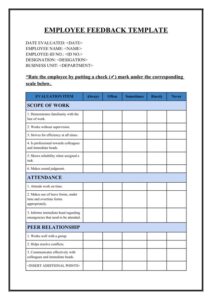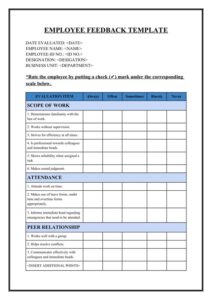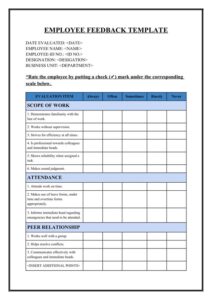A 360-degree feedback system can be an incredibly powerful tool for professional development and organizational growth. Instead of relying solely on a manager’s perspective, this comprehensive approach gathers insights from multiple sources: peers, subordinates, managers, and even self-assessments. It provides a full circle view of an individual’s performance, strengths, and areas for improvement, offering a nuanced understanding that traditional reviews often miss. This holistic feedback is invaluable for fostering a culture of continuous learning and open communication within any team.
However, the success of a 360-degree feedback program heavily depends on how it’s structured and implemented. Without a clear framework, the process can become disorganized, leading to inconsistent feedback or, worse, a negative experience for participants. This is where a well-designed employee 360 feedback survey template becomes indispensable, providing the foundation for a smooth, effective, and insightful feedback process that truly benefits everyone involved.
Why a Structured Employee 360 Feedback Survey Template is Essential for Growth
Implementing a 360-degree feedback system without a standardized approach is like navigating uncharted waters without a map. While the intention might be good, the results can be chaotic and unhelpful. A robust employee 360 feedback survey template ensures consistency across all evaluations, meaning everyone is assessed on similar criteria, making the data far more comparable and actionable.
Consistency is key not only for data analysis but also for maintaining fairness and transparency. When every participant knows what to expect and what aspects of performance are being evaluated, it builds trust in the system. This standardization also significantly reduces the administrative burden on HR teams or managers, allowing them to focus more on interpreting the feedback and guiding development plans rather than spending countless hours creating custom surveys from scratch for each employee.
Moreover, a well-structured template goes beyond just simplifying the process; it actively helps in uncovering critical insights. Often, individuals have “blind spots” – areas where their self-perception differs significantly from how others perceive them. A templated survey, by asking targeted questions across various competencies, helps to highlight these discrepancies gently and constructively, providing the individual with valuable information they might not receive through any other channel.
To truly harness the power of this multi-rater feedback, your template needs to cover the right ground. It is not just about asking questions, but asking the right questions that prompt thoughtful, specific, and actionable responses. The questions should be categorized to provide a clear overview of different skill sets and behaviors.
Key Areas to Cover in Your Survey Template
- Leadership and Management Skills: Questions assessing decision-making, delegation, vision, and team motivation.
- Communication Effectiveness: How clearly an individual conveys ideas, listens actively, and manages conflicts.
- Teamwork and Collaboration: Their ability to work with others, contribute to group goals, and resolve interpersonal challenges.
- Problem-Solving and Critical Thinking: How they approach challenges, innovate, and make sound judgments.
- Interpersonal Skills: Their approachability, empathy, and ability to build positive relationships.
- Adaptability and Learning Agility: How well they respond to change, learn new skills, and embrace feedback.
- Results Orientation: Their ability to meet objectives, manage projects, and deliver on commitments.
Maximizing Impact: Designing and Implementing Your Template Effectively
Designing an effective employee 360 feedback survey template isn’t just about listing questions; it’s about crafting an experience that encourages honest, constructive, and actionable input. First and foremost, ensure the survey maintains strict anonymity for the feedback providers. This encourages candor and reduces the fear of repercussions, which is crucial for obtaining genuine insights. Clear instructions at the beginning of the survey are also vital, guiding participants on the purpose of the feedback and how their responses will be used.
When it comes to the questions themselves, a balanced approach combining scaled ratings with open-ended comments is often most effective. Scaled questions (e.g., “On a scale of 1 to 5…”) provide quantitative data that is easy to track and analyze trends, while open-ended questions offer qualitative depth, allowing raters to provide specific examples and context. Avoid leading questions or those that could be interpreted as judgmental. Focus on observable behaviors rather than personality traits, and encourage respondents to provide constructive criticism rather than just general praise or blame.
Beyond the template’s design, its successful implementation requires thoughtful planning and communication. Clearly articulate the purpose of the 360-degree feedback program to all participants before launching the survey. Explain how the feedback will be used for individual development, not as a punitive measure. Providing adequate time for completion and sending gentle reminders can significantly boost participation rates. Most importantly, ensure that feedback recipients receive proper support in understanding and acting upon their results, perhaps through facilitated debriefs or coaching sessions.
Remember, while a template provides a strong starting point, it should be seen as a living document that can be tailored to your organization’s unique culture, values, and strategic goals. Regularly review and refine your template based on the insights gained from previous cycles. The true value of 360-degree feedback isn’t just in collecting data; it’s in the follow-up. Employees should see tangible actions taken based on the feedback, whether through personal development plans, team-wide initiatives, or organizational changes. This demonstrates that their input is valued and leads to a more engaged and high-performing workforce.
- Ensure Anonymity: Reassure participants that their individual responses will remain confidential.
- Communicate Clearly: Explain the purpose, process, and how results will be used before the survey launches.
- Provide Examples: Offer clear examples of constructive feedback to guide respondents.
- Offer Development Support: Pair feedback with coaching or resources to help individuals act on insights.
- Integrate with Development Plans: Use the feedback to create personalized growth strategies.
- Iterate and Improve: Periodically review and update your survey template based on outcomes and evolving needs.
Embracing a systematic approach to multi-source feedback can fundamentally transform how your organization fosters talent and drives performance. It moves beyond traditional top-down evaluations, offering a panoramic view that empowers individuals with a deeper understanding of their impact. By leveraging the collective wisdom of colleagues, managers, and direct reports, employees gain unparalleled insights into their professional footprint, helping them to refine skills and strengthen working relationships.
Ultimately, the goal is to cultivate an environment where constructive feedback is seen not as criticism, but as a gift for growth. A well-designed feedback mechanism, supported by clear processes, becomes a cornerstone for continuous personal and organizational development, ensuring that everyone has the tools and insights needed to thrive in their roles and contribute meaningfully to shared success.


